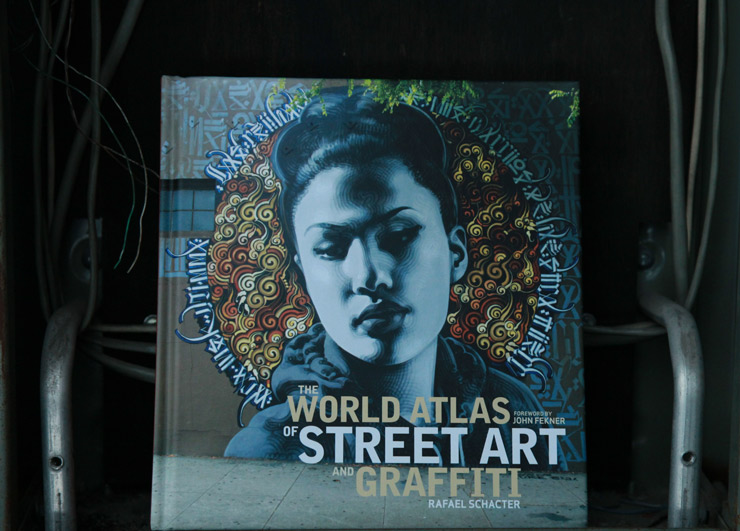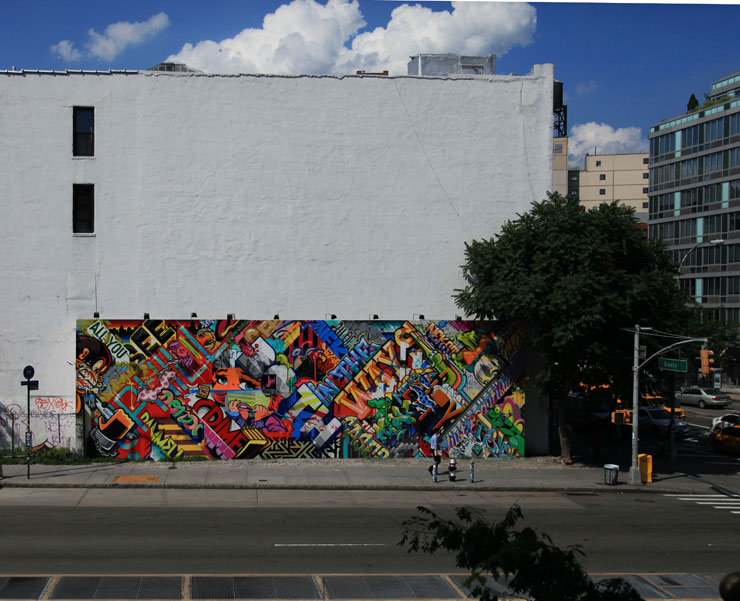Monday, February 24, 2014
'World Atlas of Street Art and Graffiti'
The World Atlas of Street Art and Graffiti by Rafael Schacter, with foreword by John Fekner
The substantial hardcover from Yale University Press is a very solid survey of largely undisputed practitioners of Street Art world wide as well as a number of lesser known names, accompanied by succinct and accurate overviews of their individual influences and styles. With contributors that include a good balance of graffiti artists, street artists, academics, authors, graphic designers, writers, and aestheticians of various stripes, Rafael Schacter has done his research; presenting 113 artists from 25 countries with illustrative photography and examples.
read more here
Sunday, February 23, 2014
CFP - March 3
http://papers.aarweb.org/content/critical-approaches-hip-hop-and-religion-group
Call for Papers:
From “Keepin’ It Real to Keepin’ it Right”: Hip-Hop, Representation, and Epistemology
We encourage submissions that explore the generational and geographic impact on hip-hop epistemologies, knowledge formations, and interpretations of such formations. Old school/new school (for one example, see: http://www.youtube.com/watch?v=0rVup66StNo), East Coast/West Coast (for another, see: http://www.youtube.com/watch?v=rvL44DxNjp), conscious/gangsta, mainstream/underground, even male/female—are but a few among a wide variety of dichotomous classifications that attempt to order and make sense of hip-hop historiography, products, output, cultural divides, conversion narratives, meaning-making and recurring social ills (e.g., homophobia, misogyny, patriarchy, among other domains). This year, we invite papers that engage various hip-hop epistemologies with attention to their construction through metaphoric and material “shout outs” to space, time, and other taxonomies. What impact do classifications like “East Coast/West Coast” “god/slave” “real/fake” or “sacred/profane” have on the epistemological and hermeneutic parameters and possibilities of what and how hip-hop and religion is studied? How do universalizing, homogenous narratives about “hip-hop” emerge from local, specific cultural products grounded within a specific space and a time? And how are scholars and artists—whether through representing one’s city, country, university, affinity, discipline or methodology—impacted by the weight of time and space shaping what we know about Hip Hop(s) and the academic engagement with it? These are but some of the questions we seek to address as we engage hip-hop epistemologies.
We also seek submissions exploring indigenous hip-hops and the manner in which questions of affinity, appropriation, and/or appreciation become troped and understood in the ensuing cultural battle for/over identity, authenticity, etc. (for a possible cosponsored papers session with the Indigenous Religious Traditions Group).
We also plan to cosponsor a prearranged session with the Religion and Popular Culture Group.
We encourage submissions that explore the generational and geographic impact on hip-hop epistemologies, knowledge formations, and interpretations of such formations. Old school/new school (for one example, see: http://www.youtube.com/watch?v=0rVup66StNo), East Coast/West Coast (for another, see: http://www.youtube.com/watch?v=rvL44DxNjp), conscious/gangsta, mainstream/underground, even male/female—are but a few among a wide variety of dichotomous classifications that attempt to order and make sense of hip-hop historiography, products, output, cultural divides, conversion narratives, meaning-making and recurring social ills (e.g., homophobia, misogyny, patriarchy, among other domains). This year, we invite papers that engage various hip-hop epistemologies with attention to their construction through metaphoric and material “shout outs” to space, time, and other taxonomies. What impact do classifications like “East Coast/West Coast” “god/slave” “real/fake” or “sacred/profane” have on the epistemological and hermeneutic parameters and possibilities of what and how hip-hop and religion is studied? How do universalizing, homogenous narratives about “hip-hop” emerge from local, specific cultural products grounded within a specific space and a time? And how are scholars and artists—whether through representing one’s city, country, university, affinity, discipline or methodology—impacted by the weight of time and space shaping what we know about Hip Hop(s) and the academic engagement with it? These are but some of the questions we seek to address as we engage hip-hop epistemologies.
We also seek submissions exploring indigenous hip-hops and the manner in which questions of affinity, appropriation, and/or appreciation become troped and understood in the ensuing cultural battle for/over identity, authenticity, etc. (for a possible cosponsored papers session with the Indigenous Religious Traditions Group).
We also plan to cosponsor a prearranged session with the Religion and Popular Culture Group.
Saturday, February 22, 2014
Tuesday, February 18, 2014
"Globalism and Vernacular in Contemporary Pakistani Rap"
"Rap’s transition from the poetry of marginalized African American
communities to the mega-hits circulating in mainstream America today
draws fierce debate. Consumerism and commodification are frequently
found guilty of eviscerating a once-radical movement with the market’s
golden handcuffs, swapping its class politics for “mere spectacle.”
In contrast, Western popular and academic assessments of rap’s journey beyond American borders, particularly in the “Muslim world,” are markedly inattentive to this commercialism. Instead, this rap evokes a virtually unanimous nostalgia. There, 1986 Los Angeles is found alive in 2013 Lebanon, and New York’s Public Enemy and L.A.’s N.W.A are discovered rhyming through Beirut’s Rayess Bek and Tehran’s Yas. So prevalent is this penchant for locating the dissent lost in American rap in “over there” rap that the Washington D.C.-based think-tank, Middle East Institute, finds Iran’s Ayatollahs battling a reanimated Tupac, and Wall Street Journal has rappers soundtracking revolt from Egypt to Iran.
The anachronism of finding 1980’s Ice Cube in contemporary Islamabad can be plausible only if one abundantly ignores the realities of contemporary rap. In a landscape where middle class white purchasers have dictated the contours of the genre’s production since at least 1992, it is particularly absurd to impose upon non-American “Muslim” rappers the romantic notion that their rap is protest.
Imagining a resurrection of resistance in “over there” rap shortchanges the breadth of the non-American musical movements. Instead, they are much more productively seen as artists in the peripheral markets of globalized rap. Such a lens appropriately situates the rappers, and accords their work the creativity and artistry it deserves.
Far from culturally-appropriate replicas of bygone American rappers, Middle East and South Asia rappers are creators of an entirely new art, vastly expanding the frontiers of the genre. “It may not have started in our communities, but just like cricket”, says Islamabadi rapper Xpolymer Dar (Muhammad Dar), “we have made rap our own.”
Indeed, in Dar’s country of Pakistan, where rap is a growing underground music genre, the ‘80s American rhymes for race and class justice are judged to have little resonance with Pakistani realities. Instead, it is the stylings of hyper-commercialized contemporary artists such as Eminem and 50 Cent that find ears, and have provided the launching pad for contemporary Pakistani rappers."
Read more here
In contrast, Western popular and academic assessments of rap’s journey beyond American borders, particularly in the “Muslim world,” are markedly inattentive to this commercialism. Instead, this rap evokes a virtually unanimous nostalgia. There, 1986 Los Angeles is found alive in 2013 Lebanon, and New York’s Public Enemy and L.A.’s N.W.A are discovered rhyming through Beirut’s Rayess Bek and Tehran’s Yas. So prevalent is this penchant for locating the dissent lost in American rap in “over there” rap that the Washington D.C.-based think-tank, Middle East Institute, finds Iran’s Ayatollahs battling a reanimated Tupac, and Wall Street Journal has rappers soundtracking revolt from Egypt to Iran.
The anachronism of finding 1980’s Ice Cube in contemporary Islamabad can be plausible only if one abundantly ignores the realities of contemporary rap. In a landscape where middle class white purchasers have dictated the contours of the genre’s production since at least 1992, it is particularly absurd to impose upon non-American “Muslim” rappers the romantic notion that their rap is protest.
Imagining a resurrection of resistance in “over there” rap shortchanges the breadth of the non-American musical movements. Instead, they are much more productively seen as artists in the peripheral markets of globalized rap. Such a lens appropriately situates the rappers, and accords their work the creativity and artistry it deserves.
Far from culturally-appropriate replicas of bygone American rappers, Middle East and South Asia rappers are creators of an entirely new art, vastly expanding the frontiers of the genre. “It may not have started in our communities, but just like cricket”, says Islamabadi rapper Xpolymer Dar (Muhammad Dar), “we have made rap our own.”
Indeed, in Dar’s country of Pakistan, where rap is a growing underground music genre, the ‘80s American rhymes for race and class justice are judged to have little resonance with Pakistani realities. Instead, it is the stylings of hyper-commercialized contemporary artists such as Eminem and 50 Cent that find ears, and have provided the launching pad for contemporary Pakistani rappers."
Read more here
Saturday, February 15, 2014
It's Delacratic: download all of De La Soul's albums for free
Thursday, February 13, 2014
Monday, February 10, 2014
Sunday, February 9, 2014
Thursday, February 6, 2014
Angel Haze - Cleaning Out My Closet
Rapper gets raw on her experience of sexual abuse
laced over Eminem's 'Cleanin Out My Closet'
Angel Haze talks to Sway about growing up in a cult, domestic abuse, sexual abuse (second video)
and performs 'Werkin Girls' (first video):
laced over Eminem's 'Cleanin Out My Closet'
Angel Haze talks to Sway about growing up in a cult, domestic abuse, sexual abuse (second video)
and performs 'Werkin Girls' (first video):
Coloring a City
“Color is something that architects are usually afraid of,” said internationally known and awarded architect Benedetta Tagliabue in an interview last May about the topic of color. A generalization probably, and you can always find exceptions of colorfully painted neighborhoods globally like the Haight in San Francisco, La Boca in Buenos Aires, Portafino in Italy, Guanajuato in Mexico, Bo-Kaap in Capetown, the favelas of Rio de Janeiro and the Blue City of India, but many of those examples speak to color blocking and pattern.
We’ve been looking at the power of Street Art to reface, re-contextualize, re-energize, and re-imagine a building and its place in the neighborhood. Some times it is successful, other times it may produce a light vertigo. The impact of work on buildings by today’s Street Artists and muralists depends not only on content and composition but largely on the palette they have chosen. It sounds trite, and self-evident perhaps, but much of Street Art is about color, and primarily on the warm scale first described by Faber Birren with his OSHA colors and color circle in the 1930s .
Read the rest here
Wednesday, February 5, 2014
Rap in 90's Commercials
As hip hop music began to boom in the late 80s and early 90s, it is easy to see the traces of its capitalization by corporations. The following are a few commercials that employed rap as a form of marketing to make their product "hip" like "parents just don't understand".
1990
1991
1992
1993
More here
1990
1991
1992
1993
More here
Sunday, February 2, 2014
Subscribe to:
Posts (Atom)






